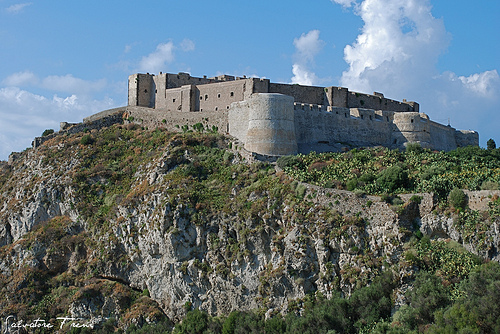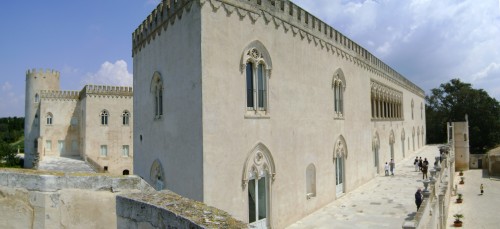For your next visit to Italy, why not step back in time with a trip to Sicily. This island (the largest in the Mediterranean) perfectly captures the essence of medieval Europe with its historical churches, temples, and castles.
Because of its location in the Mediterranean, Sicily has been cultivated by several different cultures throughout the ages. It boasts influences from Greek, Roman, Arab, Norman, Spanish, and French dominance in its art and architecture, but especially its castles, of which there are over 200.
Whether or not you’re a history-buff, visiting the castles in Sicily is a great way to experience the culture and learn about the unique history of this island. Here are five castles that should make an appearance on your itinerary!
Castello a Mare
Castello a Mare, or the Sea Castle, is located in Palermo, the chief town of Sicily. The Arabs first used this castle as an outpost to protect the harbor of Palermo, but it later became a prison under the Bourbon dynasty in 1800.
Unfortunately, in the late nineteenth century, Castello a Mare reached its end when Palermitans ravished the castle, pilfering and stripping bricks and supplies to build their own homes. Today, all that remains of the castle is the gatehouse, the tower, and the skeleton of the moat that once protected it.
This castle remains a well-kept secret from tourists, especially since it is undergoing restoration and is not always open to the public. However, seeing the historic remains of this castle is worth the experience. Getting there is simple too: from the Via Roma or Teatro Massimo district, follow Via Cavour to Via Crispi, and the castle lies just beyond the grassy field.
Castello di Caccamo
Perched on a steep cliff overlooking the San Leonardo River Valley is Sicily’s largest and best-conserved castle: Castello di Caccamo. Built by the Normans in the early Middle Ages, this castle had a significant role in Sicilian history as it served as a refuge after Baron’s revolt in 1160-61.
Over the years, it has been passed through the hands of several families—Chiaramonte, de Prades, and Amato—gaining new additions and expansions in the process. Under the Amatos, Castello di Caccamo became the palace that it is today. Just outside the gates, volunteers depict medieval life by dressing up and practicing the traditional trades in small medieval houses. If you speak some Italian, these volunteers are more than happy to fill you in on the history of the castle.
Once inside the castle walls, visitors can explore the stables, auditorium, court chapels, the keep, prisons, the “Conspiracy Room”, and the Arms room. Castello di Caccamo is open on weekdays and Saturdays from 9:00AM to 1:00PM and then again from 3:00PM to 8:00PM.
If you want a more involved tour of the castle, make an appointment with the Cultural Association Sicilia e Dintorni, which is located at the entrance of the castle. (You can also call in advance to make a reservation: 0 91 812 13 12) The tour starts with Castello di Caccamo and then ventures to the art-filled Mother Church of the Norman age.
After these two sites, the tour stops for lunch at one of the local restaurants and then continues the journey to the Church of San Benedetto alla Badia. Be prepared to go sans shoes to avoid damaging this church’s delicate tile floor. Before heading to the last attraction—the Museum of Collections of Instruments, Tools & Utensils—guests are given free time to talk with the local craftsmen and shop around.
Castello di Milazzo
Located on the Milazzo Peninsula is the Castello di Milazzo. The town of Milazzo is a product of Greek colonization, but also displays influences of Roman and Arab rule. Castello di Milazzo was built to protect the harbor to the Tyrrhenian Sea under the command of Swabian ruler Frederick II.
This castle served as the meeting place for the Sicilian Parliament in 1295 and was more recently deemed an Italian National Monument. It is open during the week from 9:30AM to 12:30PM and 3:30PM to 6:30PM. Even though the castle is closed during siesta, you can still walk through the inner courtyards. Because of its location on a rocky hilltop, the castle and its courtyards offer panoramic views in all directions. You can see the mystical Aeolian Islands as well as Europe’s largest volcano Mt. Etna on a clear day.
Castello di Donnafugata
On the southern tip of Sicily in Ragusa lies one of the island’s most notable castles: Castello di Donnafugata. This castle has made an appearance in a few famous films such as Kaos. It was built during the mid-seventeenth century, but its façade was altered in the twentieth century with the direction of Corrado Arezzo de Spuches, the Baron of Donnafugata.
These alterations introduced several variations and styles of architecture to the castle including Venetian Gothic and renaissance. Only the first floor of the castle is open to the public, but you can see the Hall of Coat of Arms, which has all of the family crests painted on the walls, the Hall of Mirrors, and the billiards room to name just a few. If it’s a nice day outside, purchase a ticket to the park and explore the gardens filled with Mediterranean plants and fig trees, the stone maze, the artificial grottoes, and the Coffee House.
The castle is open from Tuesday to Saturday from 9:00AM to 2:00PM. On Sundays, it is open from 9:00AM to 3:50PM. Admission to the castle and the park is 6€. For just the castle, it is 4€. For just the park, it is 2.50€.
After all of the walking and picture-taking, you may find yourself famished at the end of the tour. Luckily, there is a little restaurant at the entrance to Castello di Donnafugata to satiate your hunger. Trattoria Al Castello Donnafugata began as a small café but grew with the increasing tourism to the castle. Here, you will find delicious homemade, or casalinga, dishes for a reasonable price. A four-course meal including wine is about 25€ per person.
Castello di Falconara
Visiting the other castles allows you to see how the Italian nobility lived, but visiting Castello di Falconara allows you to experience how the Italian nobility lived! This castle, which once served as a breeding area for falcons, came under the ownership of the Chiaramonte-Bordonaro family who opened the castle for public use. Included in this “public use” is lodging!
Currently, Castello di Falconara houses 35 guests, offering several types of accommodations: exclusive use of the castle, bed and breakfast rooms, and the apartment. Imagine sleeping under the same roof, in the same rooms, as the Italian nobility. All of these accommodations have access to the beautiful sandy beaches. For more information, visit icastelli.
Have you ever visited one of Sicily’s Castles? Share your experience in the comments.
Written by : Laura Photo Credits : Wikipedia / Jason Sansone / Salvatore.Freni / WikiMedia




